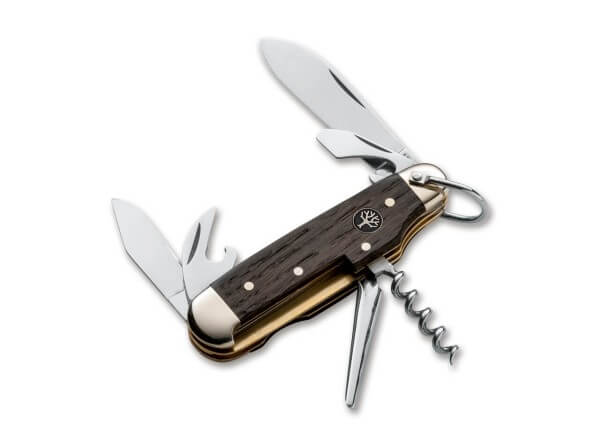The six-piece Boker Camp Knife has been handmade in our Solingen manufactory since 1869. The concept, which has been copied many times throughout history, combines numerous useful tools in a high-quality pocket knife. It has been in production longer than any other multifunctional knife from Boker.
Stamping
The two blades made of the classic Solingen blade steel 4034, the can and bottle opener as well as the slotted screwdriver are traditionally stamped out using our own stamping tools and machines, just like the total of four brass plates (alder), a brass intermediate piece and two stainless steel back springs. The four nickel silver bolsters are elaborately stamped, as are the small emblems and the nail hammer of the two blades, and the four bolsters are then punched out of the blank. They are then sawn apart in the centre and deburred by hand to produce two identical pairs.
Grinding
In the grinding shop, the bevelling, i.e. the long phase from the back to the cutting edge, is applied. For this purpose, the already hardened blade blanks are placed individually, by hand, on the blade-specific jig. Particular care is required when cooling the workpieces, as the blades may warp or even lose some of their hardness due to the heat input.
Hand polish
The two back springs are further processed in parallel in the manual plotting room. Sitting on the bench grinder, each part is individually cleaned, deburred and given an even finish. This is the only way to guarantee the perfect function of the back springs.
Shell department
The processing of the classic stag horn scales of the sports knife requires a great deal of intuition due to the wide variety of starting materials. First, the parts cut into scantlings are carefully examined and sorted. Due to the course of the horn and the different horn thicknesses of the scantlings, about 50 percent of the scantlings must first be soft-boiled so that they can be bent into shape. By then grinding the underside flat, a large proportion of the scantlings can be reused. The next step is to pair the two halves of the horn. With a trained eye, two horn halves of similar colour, structure and thickness are selected. Only then is the horn cut to the target size, the drilling and countersinking for the pins and the emblem and the grinding of the horn pieces on the head sides carried out - also all by hand.
Pre-assembly
In the pre-assembly stage, the two stag horn shells are riveted onto one tang each. The nickel silver jaws are also spot-welded to the plate. The corresponding holes are drilled so that the guide pins can hold all the components together. Afterwards, the bevel is ground and the share is milled with millimetre precision as the future position for the corkscrew. Although at this stage all the components for later assembly are in place, an elaborate intermediate step is incorporated during production. The catch strap placed on the top prevents the final machining and polishing of the upper nickel silver jaws. For this reason, the provisional assembly of the knife is done without blades and stirrups. Only after the contour of the upper nickel silver jaw has been carefully ground and polished are the provisional pins removed and the knife disassembled into its individual parts again. Only now can the actual assembly begin.
Assembly
In the assembly, the two bowls as well as the blades and all other components are assembled with the help of four nickel silver guide pins and then pressed together. Even though it is now complete with the exception of the tree shield, the sports knife is still far from its final appearance.
Finishing
In the finishing shop, the assembled components with protruding guide pins, sharp-edged corners and protruding stag horn scales are transformed into a highly polished hand caress that looks good in any waistcoat pocket. Until it is ready, each sports knife is refined to perfection on four abrasive belts of different grits and speeds, a polishing mushroom and linen cloth.
Laser engraving
Now that the knife looks largely like the final product, the world-famous tree mark is carefully applied to the front of the main blade in the form of a laser engraving. Since its foundation, no knife has left our manufactory without this seal of quality.
Final polish
The knife now corresponds in shape and contour to the final product - but the two blades and the piercing and reamer are not yet sharpened. The blades are each unfolded and pulled off by hand on the trestle at an angle of 30 degrees.
Final check
In the final inspection, the Boker emblem is inserted into the prepared blind hole. Each individual knife is carefully cleaned on the traditional wooden sorting boards and checked for proper function. Even the smallest defects are reworked so that only flawless products find their way into the product packaging made in Germany. The long journey of the sports knife through our manufactory draws to a close with its journey to the main warehouse. From there, with the purchase of the knife, a new journey begins as a reliable companion for its proud owner.

















